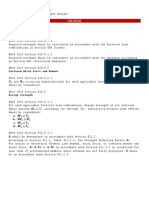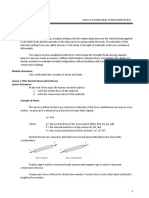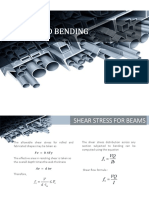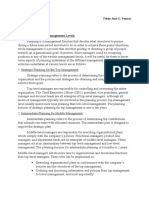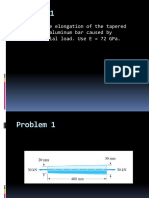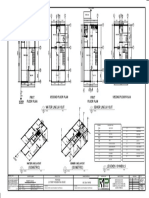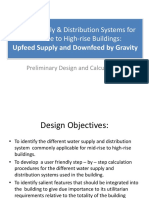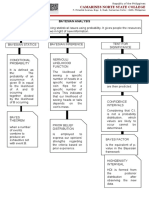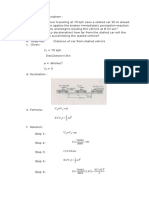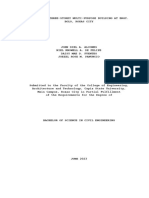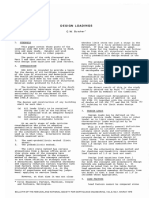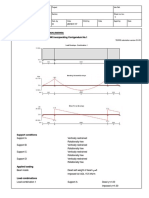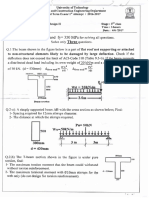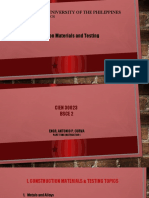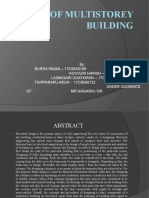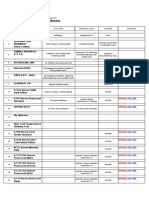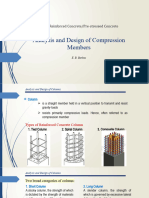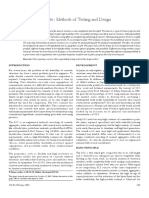0 ratings0% found this document useful (0 votes)
115 viewsNSCP Chapter 2 Summary Final
NSCP Chapter 2 Summary Final
Uploaded by
shienellajacildoThe National Structural Code of the Philippines (NSCP) 2015 Edition outlines several key aspects related to minimum design loads which are essential for ensuring structural safety and integrity. These include dead loads from structural weight, live loads from occupancy usage, seismic loads for earthquake resistance, and other loads accounting for rain, snow, and environmental forces specific to the local climate and geography. Establishing minimum design loads provides a standardized approach for structural engineers to comprehensively consider the worst case loading scenarios structures may experience over their lifespan.
Copyright:
© All Rights Reserved
Available Formats
Download as DOCX, PDF, TXT or read online from Scribd
NSCP Chapter 2 Summary Final
NSCP Chapter 2 Summary Final
Uploaded by
shienellajacildo0 ratings0% found this document useful (0 votes)
115 views2 pagesThe National Structural Code of the Philippines (NSCP) 2015 Edition outlines several key aspects related to minimum design loads which are essential for ensuring structural safety and integrity. These include dead loads from structural weight, live loads from occupancy usage, seismic loads for earthquake resistance, and other loads accounting for rain, snow, and environmental forces specific to the local climate and geography. Establishing minimum design loads provides a standardized approach for structural engineers to comprehensively consider the worst case loading scenarios structures may experience over their lifespan.
Original Description:
NATIONAL STRUCTURAL CODE OF THE PHILIPPINES
Original Title
NSCP CHAPTER 2 SUMMARY FINAL
Copyright
© © All Rights Reserved
Available Formats
DOCX, PDF, TXT or read online from Scribd
Share this document
Did you find this document useful?
Is this content inappropriate?
The National Structural Code of the Philippines (NSCP) 2015 Edition outlines several key aspects related to minimum design loads which are essential for ensuring structural safety and integrity. These include dead loads from structural weight, live loads from occupancy usage, seismic loads for earthquake resistance, and other loads accounting for rain, snow, and environmental forces specific to the local climate and geography. Establishing minimum design loads provides a standardized approach for structural engineers to comprehensively consider the worst case loading scenarios structures may experience over their lifespan.
Copyright:
© All Rights Reserved
Available Formats
Download as DOCX, PDF, TXT or read online from Scribd
Download as docx, pdf, or txt
0 ratings0% found this document useful (0 votes)
115 views2 pagesNSCP Chapter 2 Summary Final
NSCP Chapter 2 Summary Final
Uploaded by
shienellajacildoThe National Structural Code of the Philippines (NSCP) 2015 Edition outlines several key aspects related to minimum design loads which are essential for ensuring structural safety and integrity. These include dead loads from structural weight, live loads from occupancy usage, seismic loads for earthquake resistance, and other loads accounting for rain, snow, and environmental forces specific to the local climate and geography. Establishing minimum design loads provides a standardized approach for structural engineers to comprehensively consider the worst case loading scenarios structures may experience over their lifespan.
Copyright:
© All Rights Reserved
Available Formats
Download as DOCX, PDF, TXT or read online from Scribd
Download as docx, pdf, or txt
You are on page 1of 2
CHAPTER 2: MINIMUM DESIGN the structural behavior under various
loads including static and dynamic
LOADS analysis techniques. It may include
topics like structural modeling, analysis
SUMMARY
software, and methods for assessing
Chapter 2 of the NSCP typically covers the stability. It may also include information
general provisions related to structural design on how to calculate forces, moments,
and construction practices in the Philippines. and stresses in structural members.
Here is a general outline of what Chapter 2 of 7. Design Criteria of Structural
such codes covers: Elements: Specific design requirements
for different structural elements such as
1. Definition: This provides definitions of
beams, columns, slabs, walls, and
various terms and concepts used
connections. This section may include
throughout the code to ensure a
design formulas, equations, and design
common understanding among
charts. This section typically outlines the
designers, engineers, and builders.
design criteria and performance
2. General Design Requirements: This
objectives that structures must meet. It
section typically outlines the
may specify safety factors, design
fundamental principles and requirements
loadings, and other factors that influence
for structural design. It may include
the design process.
considerations for safety, load
8. Special Design Provisions: Any
combinations, and design
special provisions or considerations for
methodologies.
unique situations, such as seismic
3. Loadings or Load Combinations: This
design requirements, design for extreme
section provides information on various
events, or specific regional conditions.
types of loads that structures may be
9. Construction Requirements:
subjected to, such as dead loads, live
Guidelines related to the construction
loads, wind loads, seismic loads, and
process, including quality control,
other environmental factors. It specifies
inspection, and testing of materials and
how these loads should be calculated
structures.
and applied in design. These load
10. Structural Integrity and Safety: This
combinations are crucial for ensuring
section emphasizes the importance of
that the structure can safely support all
ensuring the structural integrity and
expected loads and environmental
safety of buildings and other structures.
conditions.
It may include provisions related to
4. Materials: Information about the
quality control, inspections, and
materials such as the types and kinds
maintenance.
that can be used in construction, their
11. Appendices and References:
properties, and limitations. This section
Additional information, tables, and
often covers concrete, steel, masonry,
references that supplement the main
and other materials. They should be
content of the chapter.
tested and approved for use in structural
elements. Engineers and architects typically use it as a
5. Foundation Design: Guidelines for reference to ensure that structures are
designing foundations to support the designed and constructed safely and in
structure safely. This may include compliance with national standards. It's crucial
requirements for soil investigations, to consult the specific edition of the NSCP in
bearing capacity calculations, and use and work with qualified professionals when
foundation types. applying its guidelines to a construction project.
6. Structural Analysis: Explanation of the
methods and techniques for analyzing
General Idea of Chapter 2: These requirements are essential for
earthquake-resistant construction.
The National Structural Code of the Philippines
5. Rain Loads: The NSCP 2015 may
(NSCP) 2015 Edition provides guidelines and
specify minimum design loads related to
specifications for the design of buildings and
rain, especially in areas with a high risk
other structures in the Philippines. One of the
of flooding. These loads account for the
fundamental concepts in the NSCP 2015, as in
additional weight and pressure caused
previous editions, is the determination of
by rainwater accumulation on roofs,
minimum design loads. These loads are
surfaces, and structural components.
essential for ensuring the safety and structural
6. Snow Loads: In regions prone to heavy
integrity of buildings and structures in various
snowfall, the NSCP 2015 may include
environmental conditions. The NSCP 2015
provisions for minimum snow loads to
outlines several key aspects related to
account for the weight of snow on roofs
minimum design loads:
and other surfaces.
1. Dead Loads: Dead loads are the 7. Other Environmental Loads: The
permanent, static loads that result from NSCP 2015 addresses other
the weight of the structure itself, environmental loads such as soil lateral
including walls, floors, roofs, and any loads, temperature effects, and wave
fixed equipment or materials. The NSCP forces (for coastal structures) to ensure
2015 specifies minimum dead loads for comprehensive structural design
different building materials and considerations.
components to account for the self-
The idea behind establishing minimum design
weight of the structure accurately
loads in the NSCP 2015 is to provide a
2. Live Loads: Live loads are dynamic
standardized and safety-focused approach to
loads that result from the occupancy and
structural engineering. These minimum loads
intended use of a building. The NSCP
are based on local climatic and geological
2015 provides guidelines for determining
conditions and are intended to ensure that
minimum live loads for various
structures are designed to withstand the worst-
occupancy categories and types of
case scenarios they may encounter during their
spaces, such as residential, commercial,
service life. Engineers and architects use these
industrial, and public areas. These loads
minimum design loads as a basis for designing
ensure that structures can safely support
buildings and structures that are safe, durable,
the people, furniture, and equipment
and resilient to environmental forces and
they are designed to accommodate.
hazards.
3. Wind Loads: Wind loads are the forces
exerted by wind on the external surfaces
of a structure. The NSCP 2015 provides
criteria for calculating wind loads based
on factors such as the geographical
location, building height, exposure
category, and wind speed. These loads
are crucial for designing buildings that
can withstand wind forces and maintain
structural stability.
4. Seismic Loads: The NSCP 2015
considers seismic loads, which are
associated with earthquakes. It provides
seismic hazard maps and guidelines for
determining seismic design forces based
on the seismic zone and soil conditions.
You might also like
- Metric Handbook - StructureDocument50 pagesMetric Handbook - StructurexufafruitjuiceNo ratings yet
- CDBM Mod02 AnswersDocument22 pagesCDBM Mod02 AnswersMoin Kabir MoinNo ratings yet
- A) Ability To Function On Multidisciplinary Teams B) Ability To Communicate EffectivelyDocument11 pagesA) Ability To Function On Multidisciplinary Teams B) Ability To Communicate EffectivelyJazcel GalsimNo ratings yet
- Chapter6-Force System in Space PDFDocument25 pagesChapter6-Force System in Space PDFBejong Boy0% (1)
- Midterm Exam 2017 18Document2 pagesMidterm Exam 2017 18Ellarence RafaelNo ratings yet
- WF-2 Plan: Typical Footing DetailDocument1 pageWF-2 Plan: Typical Footing DetailErika Faye Calzeta100% (1)
- TCS Q 113.03 R.1Document43 pagesTCS Q 113.03 R.1Azhar Ali100% (2)
- Reinforced Concrete Design Engr. Rimar C. Liguan: ColumnsDocument24 pagesReinforced Concrete Design Engr. Rimar C. Liguan: ColumnsCristina Sarmiento100% (1)
- Design of Shells (Example Problem)Document5 pagesDesign of Shells (Example Problem)AkarshGowdaNo ratings yet
- Solution To Problem 204 Stress-Strain Diagram - Strength of Materials ReviewDocument3 pagesSolution To Problem 204 Stress-Strain Diagram - Strength of Materials ReviewimrancenakkNo ratings yet
- Module 1 Simple StressDocument14 pagesModule 1 Simple StressJay LopezNo ratings yet
- Session 4 - Electrical LayoutDocument17 pagesSession 4 - Electrical LayoutCeino Rey QuimintanNo ratings yet
- CM 2 Ceemec30 PDFDocument63 pagesCM 2 Ceemec30 PDFenel eneruNo ratings yet
- Loads and Load FactorsDocument10 pagesLoads and Load FactorsDimal HewaNo ratings yet
- CO1 - CPR FadrigalanDocument6 pagesCO1 - CPR FadrigalanThorxus LeivnggerNo ratings yet
- Cee 109 - First ExamDocument43 pagesCee 109 - First ExamRonald Renon QuiranteNo ratings yet
- MASONRY HandoutDocument20 pagesMASONRY HandoutJoshua Andrei A. DelacruzNo ratings yet
- ACFrOgCaVYe61igbFWxMaeqFr52mJGwWmb75LUR4b yEOmzUJ97rv5Z-nFGwHrapJtsPEB2fPsaeAcTq8YF3pLbZQRev8k0ySpM5QmUoH2yaRLWpPx6I3MhUWl9HQy Ce jEm6P34lKTZ6eCLiWTDocument10 pagesACFrOgCaVYe61igbFWxMaeqFr52mJGwWmb75LUR4b yEOmzUJ97rv5Z-nFGwHrapJtsPEB2fPsaeAcTq8YF3pLbZQRev8k0ySpM5QmUoH2yaRLWpPx6I3MhUWl9HQy Ce jEm6P34lKTZ6eCLiWTHilton D. CalawenNo ratings yet
- Chapter IV Shear and Moment in Beams 4.4Document6 pagesChapter IV Shear and Moment in Beams 4.4Joshua John JulioNo ratings yet
- PHY-433 09 Work, Energy and PowerDocument23 pagesPHY-433 09 Work, Energy and PowerKim OpenaNo ratings yet
- Consmat Lab Manual 2016 PDFDocument57 pagesConsmat Lab Manual 2016 PDFAngelito RamosNo ratings yet
- CS9 Operation ManagementDocument5 pagesCS9 Operation ManagementRalphMarwinUsonCorpuz0% (1)
- Cie 112 Sas 14Document5 pagesCie 112 Sas 14Jessa Mae B. MostolesNo ratings yet
- Geotech Coaching 2Document13 pagesGeotech Coaching 2RODOLFO ARMEANo ratings yet
- Solution: PROBLEM 13.12Document2 pagesSolution: PROBLEM 13.12Nattamon PetchkeawNo ratings yet
- Engineering Laws - The CE LawDocument6 pagesEngineering Laws - The CE Lawjun junNo ratings yet
- Final Exam - HydraulicsDocument1 pageFinal Exam - HydraulicsMisael CamposanoNo ratings yet
- Compression Members PDFDocument20 pagesCompression Members PDFMichael ReyesNo ratings yet
- Experiment 1 Sieve AnalysisDocument7 pagesExperiment 1 Sieve AnalysisTyrone PaulinoNo ratings yet
- Shear and BendingDocument20 pagesShear and BendingApril KristineNo ratings yet
- Specifications: Project: Proposed Two (2) Storey Residential Location: OwnerDocument4 pagesSpecifications: Project: Proposed Two (2) Storey Residential Location: OwnerJ.P.Almera ArDesignNo ratings yet
- Planning: Planning at Various Management LevelsDocument5 pagesPlanning: Planning at Various Management LevelsFelsie Jane PenasoNo ratings yet
- Problems On StrainDocument16 pagesProblems On StrainRalph Evidente33% (3)
- STRUCTURAL THEORY 1 MIDTERM EXAMINATIOnsDocument2 pagesSTRUCTURAL THEORY 1 MIDTERM EXAMINATIOnsYoh AbecillaNo ratings yet
- Architects Guidelines (Official Gazette) - 2pgsDocument28 pagesArchitects Guidelines (Official Gazette) - 2pgsIssa LunaNo ratings yet
- Surveying WORKSHEET 8bDocument2 pagesSurveying WORKSHEET 8bReyy ArbolerasNo ratings yet
- Lab 8 ...Document3 pagesLab 8 ...shaweeeng 101No ratings yet
- Ce 4111 Module 1 Unit 2.1 Design Requirements Part Design Speed Sight DistanceDocument26 pagesCe 4111 Module 1 Unit 2.1 Design Requirements Part Design Speed Sight Distancewalangforever.rsNo ratings yet
- Module 1 Intro To Structural AnaylsisDocument13 pagesModule 1 Intro To Structural AnaylsisshnslaveNo ratings yet
- Highway and Railroad Engineering: Reversed CurvesDocument8 pagesHighway and Railroad Engineering: Reversed CurvesDirect XNo ratings yet
- Water Line Layout Sewer Line Layout: C B A C B A C B A C C B ADocument1 pageWater Line Layout Sewer Line Layout: C B A C B A C B A C C B ALouvs GandaNo ratings yet
- Engineering Mechanics (Statics) : A B A B A B BDocument2 pagesEngineering Mechanics (Statics) : A B A B A B BMallene EhurangoNo ratings yet
- CE2232 Finals ReviewerDocument16 pagesCE2232 Finals ReviewerJosephh CryptNo ratings yet
- Sketch Plan: LOT 5048 and 5455 and LOT 1, (LRC) PCS-5626 CAD 220 Tacloban CadastreDocument1 pageSketch Plan: LOT 5048 and 5455 and LOT 1, (LRC) PCS-5626 CAD 220 Tacloban CadastreBrian Jose AnosNo ratings yet
- Highrise Upfeed Supply SystemDocument54 pagesHighrise Upfeed Supply SystemJeffrey CaparasNo ratings yet
- Em Lecture 1Document7 pagesEm Lecture 1hiba7hNo ratings yet
- Strength of Materials Chapter 8Document22 pagesStrength of Materials Chapter 8ANTILA JASMINENo ratings yet
- Septic Tank Deisgn: (1999 REV. NPC)Document15 pagesSeptic Tank Deisgn: (1999 REV. NPC)John AlbertNo ratings yet
- Analysis For External Reactions and Internal Stress Resultants of Statically Determinate StructuresDocument5 pagesAnalysis For External Reactions and Internal Stress Resultants of Statically Determinate StructuresJanice RamonNo ratings yet
- Plate No.2 DynamicsDocument3 pagesPlate No.2 DynamicsEunice CorreaNo ratings yet
- CMT Lesson 2Document14 pagesCMT Lesson 2April Jhen BenavidezNo ratings yet
- Upang Cea Common Bes025 p3Document69 pagesUpang Cea Common Bes025 p3Jairo OntongNo ratings yet
- Lesson 1 - CE Laws, Contracts and EthicsDocument23 pagesLesson 1 - CE Laws, Contracts and EthicsJohn Rodolfo BultronNo ratings yet
- 7 Trapezoidal Combined FootingDocument9 pages7 Trapezoidal Combined FootingMark Angelo FloresNo ratings yet
- Group 2 - em (Bayesian Analysis)Document4 pagesGroup 2 - em (Bayesian Analysis)Balte, Richard F.No ratings yet
- Transportation Engineering PDF FreeDocument13 pagesTransportation Engineering PDF FreeDenise DimayaNo ratings yet
- Rectangular Section - T-Sections (USD Method)Document8 pagesRectangular Section - T-Sections (USD Method)Niel John BaquilarNo ratings yet
- 4 One Way SlabDocument22 pages4 One Way SlabCandice Aberin Mag-alasinNo ratings yet
- New ProjDocument30 pagesNew ProjHueyNo ratings yet
- Solved ProblemDocument35 pagesSolved ProblemTroy BaongNo ratings yet
- A Proposed Three Storey Multi Purpose Building at Brgy. Bolo Roxas City Capiz1Document304 pagesA Proposed Three Storey Multi Purpose Building at Brgy. Bolo Roxas City Capiz1arnoldleorenz17No ratings yet
- Load Difference in NZ CodeDocument7 pagesLoad Difference in NZ CodeAslam KyonNo ratings yet
- SlabDocument4 pagesSlabJhunel Ivan GoyenaNo ratings yet
- Steel Beam Analysis & Design (Bs5950) in Accordance With BS5950-1:2000 Incorporating Corrigendum No.1Document4 pagesSteel Beam Analysis & Design (Bs5950) in Accordance With BS5950-1:2000 Incorporating Corrigendum No.1MenchebelleNo ratings yet
- Irc SP 139-2023Document41 pagesIrc SP 139-2023anant11235No ratings yet
- Smat Quiz QuestionnairreDocument12 pagesSmat Quiz QuestionnairreGielyn DiwaNo ratings yet
- فاينل تصميم خرسانه مسلحه ثالث مدنيDocument13 pagesفاينل تصميم خرسانه مسلحه ثالث مدنيAbdulaziz hazemNo ratings yet
- Joint Details of MCWDocument1 pageJoint Details of MCWVijay SinghNo ratings yet
- Comparative Study of Steel Structure With and Without Floating Columns in EtabsDocument13 pagesComparative Study of Steel Structure With and Without Floating Columns in EtabsBehroz BehzadNo ratings yet
- Long-Term Structural Performance of Modular High-Rise Concrete Building (CEB-FIB International Conference Oslo June 2022)Document10 pagesLong-Term Structural Performance of Modular High-Rise Concrete Building (CEB-FIB International Conference Oslo June 2022)Goh Kay YunNo ratings yet
- Advanced Structural AnalysisDocument19 pagesAdvanced Structural AnalysisMohammed Abid0% (1)
- Analisis Pekerjaan TPTDocument2 pagesAnalisis Pekerjaan TPTDeny Kristian SipayungNo ratings yet
- Construction Materials and Testing ModuleDocument66 pagesConstruction Materials and Testing Moduleacurvz2005No ratings yet
- Rajeev Shah & Associates: Structural Design Basis ReportDocument8 pagesRajeev Shah & Associates: Structural Design Basis Reportrajeev shahNo ratings yet
- DESIGN OF MULTISTOREY BUILDING-1.pptx NEWDocument7 pagesDESIGN OF MULTISTOREY BUILDING-1.pptx NEWPavan BurraNo ratings yet
- Approved Material ListDocument3 pagesApproved Material ListSM MEGAMALL TOWERNo ratings yet
- تصميم بلاطه هردي باتجاهينDocument8 pagesتصميم بلاطه هردي باتجاهينابراهيم الحدرميNo ratings yet
- CE 135 - Analysis and Design of Columns - Short Columns - Updated 1Document41 pagesCE 135 - Analysis and Design of Columns - Short Columns - Updated 1Paul Justin MangatNo ratings yet
- Cable-Stayed Bridges: - JIGAR .S.SHAH (CP1712) - ADNAN SHAIKH (CP1812) - MEGHA SINGH (CP1912)Document55 pagesCable-Stayed Bridges: - JIGAR .S.SHAH (CP1712) - ADNAN SHAIKH (CP1812) - MEGHA SINGH (CP1912)Van Cuong PhamNo ratings yet
- Self-Compacting Concrete: Methods of Testing and Design: P Kumar, Non-MemberDocument6 pagesSelf-Compacting Concrete: Methods of Testing and Design: P Kumar, Non-Membervinay rodeNo ratings yet
- ME1101 Lecture3-Bending StressDocument47 pagesME1101 Lecture3-Bending StressNADULA RUSIRUNo ratings yet
- Future of The Champlain Bridge, by DelcanDocument24 pagesFuture of The Champlain Bridge, by Delcanandyriga100% (1)
- Black Book of Design and Analysis of Residential Building ( g+2 ) by Using STAAD ProDocument67 pagesBlack Book of Design and Analysis of Residential Building ( g+2 ) by Using STAAD Prodeepakbhurkud49No ratings yet
- Structural Fire Precautions: 3.1 GeneralDocument39 pagesStructural Fire Precautions: 3.1 GeneralEric Ng S LNo ratings yet
- 4.3 - Set Up Cost X For Measuring Raft SlabDocument24 pages4.3 - Set Up Cost X For Measuring Raft Slabrishishah105No ratings yet
- Sieve Analysis of Coarse AggDocument10 pagesSieve Analysis of Coarse AggcaddNo ratings yet
- CFA PilesDocument293 pagesCFA Pilesfludor100% (1)
- Beam Analysis: LP LB LRDocument2 pagesBeam Analysis: LP LB LRLester John PrecillasNo ratings yet
- Modelling and Analysis of Reinforced Concrete Beam Under Flexure Using AnsysDocument9 pagesModelling and Analysis of Reinforced Concrete Beam Under Flexure Using AnsysjayanthNo ratings yet








